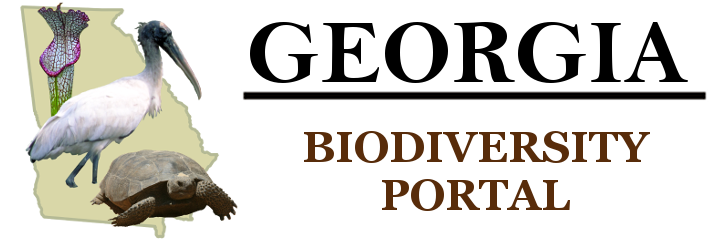







Loading profile. Please wait . . .
Packera millefolium (Torr. & Gray) W.A. Weber & A. Love
Blue Ridge Ragwort




Federal Protection: No US federal protection
State Protection: Threatened
Global Rank: G3
State Rank: S1
Element Locations Tracked in Biotics: Yes
SWAP 2015 Species of Greatest Conservation Need (SGCN): Yes
SWAP 2025 Species of Greatest Conservation Need (SGCN): Yes
2025 SGCN Priority Tier: High Conservation Concern
Element Occurrences (EOs) in Georgia: 2
Habitat Summary for element in Georgia: High elevation rock outcrops
Perennial herb 12 - 32 inches (30 - 70 cm) tall. Its stems are erect and ribbed, with patches of woolly hairs in the angle between leaf base and stem. The lower leaves are up to 12 inches (30 cm) long, alternate, deeply divided into many segments, each segment subdivided at least once into many very narrow segments, similar to yarrow leaves; the stem leaves are similar but smaller. Flower heads are held singly at the tips of branches; the heads are surrounded at the base by a whorl of green involucral bracts about 0.2 inch (4 - 7 mm) high. Each head consists of 8 - 13 yellow ray flowers up to 0.5 inch (8 - 12 mm) long and many darker yellow disk flowers tightly packed in the center of the head. Fruits are dry, seed-like achenes less than 0.1 inch (about 2 mm) long.
Small's Ragwort (Packera anonyma or Senecio anonymus) is a common, sometimes weedy, species throughout Georgia. Its leaves are deeply divided into coarsely toothed (but not finely subdivided) segments.
Balsam Ragwort (Packera paupercula or Senecio pauperculus, Special Concern) occurs in moist meadows and prairies in Floyd County. It resembles other ragworts, but the lower leaves are oval or lance-shaped and toothed; it has fewer than 20 flower heads per plant. For more information, see: http://beta.floranorthamerica.org/Packera_paupercula
High elevation granite outcrops, domes, and cliffs.
Blue Ridge Golden Ragwort is a perennial herb that reproduces sexually by seed. Its flowers attract large insects, such as butterflies, and smaller ones, such as bees. Butterflies make use of the ray flowers for landing platforms while they probe for nectar; bees are able to quickly visit a large number of disk flowers and gather the minute amounts of nectar available from each flower. Small insects visit a large number of ragwort flower heads in a relatively small area, effecting self-pollination of flowers within a head or on the same plant; large insects tend to fly longer distances, visiting a variety of plants, increasing the chances of cross-pollination. Ragwort seeds are dispersed by animals, gravity, and possibly wind.
Surveys are best conducted during flowering (late May–July) but this species is the only one in its habitat with yarrow-like leaves and may be identified throughout the growing season.
Georgia, South Carolina, North Carolina, and Virginia.
Development of ridgelines and other high-elevation sites for second homes. Trampling by hikers and climbers and subsequent erosion. Disturbance invites invasion, especially in damp areas, by the common and weedy Small's Ragwort (Packera anonyma) which has the potential to genetically “swamp” Blue Ridge Golden Ragwort.
| Threat 1 | Threat 2 | Threat 3 | |
|---|---|---|---|
| General Threat | Human intrusions & disturbance | Natural system modifications | Invasive & other problematic species, genes & diseases |
| Specific Threat | None | None | None |
Three populations are known, 2 on private land, one on National Forest land.
Protect high elevation outcrops and domes from development, foot traffice, and overuse by climbers and hikers. Direct foot traffic away from plants. Remove nearby populations of Small's Ragwort (Packera anonyma) which threatens to genetically “swamp” Packera millefolia by hybridization.
Chafin, L.G. 2007. Field guide to the rare plants of Georgia. State Botanical Garden of Georgia and University of Georgia Press, Athens.
Cronquist, A. 1980. Vascular flora of the southeastern United States, Vol. 1, Asteraceae. University of North Carolina Press, Chapel Hill.
GADNR. 2020. Element occurrence records for Packera millefolium. Georgia Department of Natural Resources, Wildlife Resources Division, Social Circle, Georgia.
Gramling, A.E. 2006. A conservation assessment of Packera millefolium, a Southern Appalachian endemic. M.S. Thesis. University of North Carolina, Chapel Hill. https://cdr.lib.unc.edu/concern/dissertations/3n204026f?locale=en
Kral, R. 1983. A report on some rare, threatened, or endangered forest-related vascular plants of the South. Technical Publication R8-TP2. United States Forest Service, Atlanta.
Massey, J.R., D.K.S. Otte, T.A. Atkinson, and R.D. Whetstone. 1983. Atlas and illustrated guide to the threatened and endangered vascular plants of the mountains of North Carolina and Virginia, Technical Report SE-20. Department of Agriculture, Southeastern Forest Experiment Station, Asheville, North Carolina. https://www.srs.fs.usda.gov/pubs/gtr/gtr_se020.pdf
NatureServe. 2019. Packera millefolium comprehensive report. NatureServe Explorer. Arlington, Virginia. http://explorer.natureserve.org/servlet/NatureServe?searchName= Packera+millefolium
Patrick, T.S., J.R. Allison, and G.A. Krakow. 1995. Protected plants of Georgia. Georgia Department of Natural Resources, Natural Heritage Program, Social Circle.
Schmitt, J. 1980. Pollinator foraging behavior and gene dispersal in Senecio (Compositae). Evolution 34(5): 934-943. https://doi.org/10.1111/j.1558-5646.1980.tb04031.x
Trock, D.K. 2006. Packera millefolium species account. Flora of North America, Vol. 20, Magnoliophyta: Asteridae, Part 7: Asteraceae, Part 2. Oxford University Press, New York.
Weakley, A.S. 2015. Flora of the southern and mid-Atlantic States. University of North Carolina Herbarium, University of North Carolina, Chapel Hill. http://www.herbarium.unc.edu/flora.htm
Linda G. Chafin
L. Chafin, Jul. 2008: original account
K. Owers, Feb. 2010: added pictures
L. Chafin, Mar. 2020: updated original account



